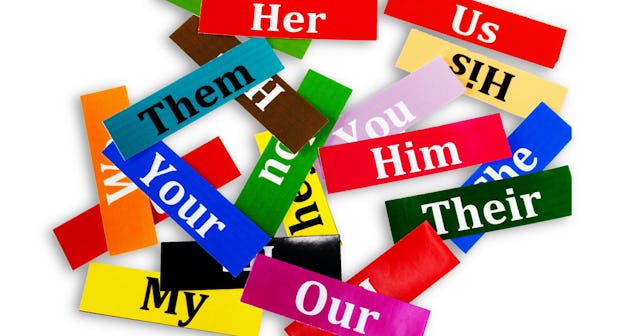Gender Neutral Pronouns Aren’t New — Here’s Where They Come From

Just because something is new to you doesn’t mean its very existence is new. This is the same for the new use of something you thought was set in stone. This logic can be applied to many things — yogurt can be turned into sour milk, for example — but I’m specifically referring to gender neutral pronouns. The rise in their use and awareness may be new, but they have been used for centuries and for many different reasons. You have likely used them in everyday communication without realizing it. Let’s take a stroll down history lane.
They Could Be Anyone
People have been using third-gender and gender neutral pronouns in some capacity as early as the 14th century. In his book, What’s Your Pronoun? Beyond He and She, Dennis Baron, professor of English and linguistics at the University of Illinois examines the history of gender neutral pronouns and the importance of their use. While the use of they/them pronouns is now most commonly known for nonbinary and gender nonconforming individuals, Baron reminds us that the singular use of ‘they’ “has always been a popular device for writers when gender is unknown, irrelevant, or when it needs to be concealed to protect the anonymity of a person you’re talking about.”
Geoffrey Chaucer used the singular ‘they’ as early as 1386 in The Canterbury Tales; Shakespeare often used they/them pronouns in his work, specifically in Hamlet in 1599; and Jane Austen used them in her 1813 book Pride and Prejudice. Their use at the time wasn’t necessarily to define people outside of the gender binary, but it shows the very old origins of they/them pronouns used in the singular sense that now lives as the standard in writing style guides and dictionaries.
You (“you” can be plural and singular too) have likely used they/them pronouns to refer to a singular person as well. If you find a water bottle or backpack at the park you’re likely to look around and say, “Oh, someone forgot their water bottle. I hope they remember to come back for it. I’ll take it to the lost and found for them if it’s still here when I leave.” You don’t know the person’s gender and it’s just too cumbersome to say ‘his or her’ repeatedly.
Gender Neutral Pronouns Include Women
nadia_bormotova/Getty
Over time the use of third gender and gender neutral pronouns was used as a way to push forward the women’s rights movement in the late 19th century. ‘He’ was the generic pronoun used to describe men and women but was interpreted to benefit men and patriarchal systems. Baron says, “Suffragists argued from the 1870s to the early 1900s that if ‘he’ is treated as generic in criminal law, then the voter ‘he’ should include women as well.” The courts didn’t agree. Women were allowed to pay taxes and be charged with crimes while being referred to as ‘he’ but they weren’t given a voice when they wanted to vote.
As I stated above, consistently writing ‘he/she’ or ‘his/hers’ becomes heavy-handed. Kelly Ann Sippell’s 1991 Master’s thesis titled Solving the Great Pronoun Problem, highlighted the following third-person and gender neutral pronouns that were used to include and assume ‘him and her’ or ‘his and hers’ in a singular word: hes, hiser, hem, ons, e, heer, he’er, hesh, se, heesh, herim, co, tey, per, na, en, herm, hir, and shey.
But the word that got the most traction before other widely used third-person pronouns was the word ‘thon.’ Thon was coined by Charles Crozat (C.C.) Converse in 1858 and was a contracted form of ‘that one.’ The word was included in Merriam-Webster’s Second New International Dictionary in 1934 as “a proposed genderless pronoun of the third person,” but was removed in their third, Unabridged dictionary in 1961.
Our language continues to evolve, especially as rights for gender equality and equity are being advocated for by and for marginalized groups. A study found that the use of gender neutral pronouns and the switch away from using he/him pronouns as the default to talk about all people reduces mental biases that feed into patriarchal systems and toxic masculinity. Their use also improves attitudes toward women and the queer community.
Gender Neutral Pronouns For Identities Outside Of Gender Binaries
Nonbinary, transgender, and gender nonconforming folks have existed since humans have existed, but giving names and pronouns to our identities is often met with resistance and disrespect when we offer pronouns that aren’t male or female. The same is true when folks use a mix of gender and gender neutral pronouns. Halsey, for example, uses she/they pronouns. Ze, hir, and xe pronouns are also used by folks who don’t identify as either male or female. This video is a great primer to better understand why folks use gender neutral pronouns and how you can learn how to use them.
If you want to keep learning, this guide offers a more thorough explanation and tips on how to be more inclusive in your language, with strangers, and at work.
Gender neutral pronouns serve several purposes. They’re inclusive of all genders; they make communication more efficient, and they’re used for specific identities of people who fall outside of the binary of he/him or she/her pronouns. Gender neutral pronouns aren’t new and will continue to gain popularity, especially in the growing queer community, as they become normalized in society. And if you identify as a woman their inclusion into the written language was — and is — for your benefit too.
This article was originally published on